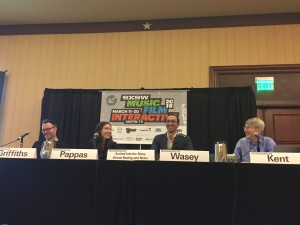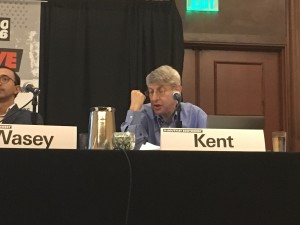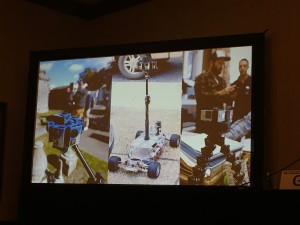We experience news in different ways, but 2016 is bringing us a new revolution by immersing us in stories through virtual reality.
 Hayley Pappas, Head of Films for RYOT, discussed the success of VR content that has been published from RYOT. ROYT is an immersive media company whose mandate is to connect every story with an action. “VR has presented itself as an exciting storytelling tool, being able to tell stories in a way that compels people to not just care, but do something,” Pappas said. ROYT had wanted to step into VR, but hesitated until the technology became more accessible. “The moment we had durable technology, we jumped at the opportunity of VR. Our first VR news piece was the Nepal Quake Project. We figured out this medium worked. We got the story out while it was still relevant, and in this experience you’re standing on the ground surrounded by children and families and see the earthquake in a way that you wouldn’t be able to through headlines or a picture. It got picked up by 200 media companies instantaneously. The VR film was a news story, it was one that made people care and understand in a different way,” Pappas said. Since the Nepal Quake Project, RYOT has progressed in VR and brought 360 to their audience.
Hayley Pappas, Head of Films for RYOT, discussed the success of VR content that has been published from RYOT. ROYT is an immersive media company whose mandate is to connect every story with an action. “VR has presented itself as an exciting storytelling tool, being able to tell stories in a way that compels people to not just care, but do something,” Pappas said. ROYT had wanted to step into VR, but hesitated until the technology became more accessible. “The moment we had durable technology, we jumped at the opportunity of VR. Our first VR news piece was the Nepal Quake Project. We figured out this medium worked. We got the story out while it was still relevant, and in this experience you’re standing on the ground surrounded by children and families and see the earthquake in a way that you wouldn’t be able to through headlines or a picture. It got picked up by 200 media companies instantaneously. The VR film was a news story, it was one that made people care and understand in a different way,” Pappas said. Since the Nepal Quake Project, RYOT has progressed in VR and brought 360 to their audience.
 Thomas Kent, the Standards Editor at Associated Press, talked about the ethical challenges that still remain in virtual reality. “It’s hard to come up with an ethical construct when it’s still so new. Consumers are beginning to get a steady stream of VR news production. In the next year or so, two million people will be forming beliefs of what VR news actually is. Is VR real news told in an immersive meaningful way? Is it just some cool technology people will move on from? Or is it the new tool for propaganda?” Kent said. He believes we need to be clear now on what we intend for the successful future of VR. There are questions that arise such as is VR news supposed to be the event itself, an objective report, or a fictionalization based on a true story. “There’s this reality part where everything is 100% real, you can walk around objects and see how they are from any side. But then there are scenes that are recreated digitally, it’s close to the event, but not the event itself. So it raises a question of is VR the real event or not? It would be good to get to a point where we set a general set of principles for VR while we still have audiences forming views of VR news. We need to make sure people view VR journalism as transparent and credible,” Kent said.
Thomas Kent, the Standards Editor at Associated Press, talked about the ethical challenges that still remain in virtual reality. “It’s hard to come up with an ethical construct when it’s still so new. Consumers are beginning to get a steady stream of VR news production. In the next year or so, two million people will be forming beliefs of what VR news actually is. Is VR real news told in an immersive meaningful way? Is it just some cool technology people will move on from? Or is it the new tool for propaganda?” Kent said. He believes we need to be clear now on what we intend for the successful future of VR. There are questions that arise such as is VR news supposed to be the event itself, an objective report, or a fictionalization based on a true story. “There’s this reality part where everything is 100% real, you can walk around objects and see how they are from any side. But then there are scenes that are recreated digitally, it’s close to the event, but not the event itself. So it raises a question of is VR the real event or not? It would be good to get to a point where we set a general set of principles for VR while we still have audiences forming views of VR news. We need to make sure people view VR journalism as transparent and credible,” Kent said.
VR is clearly a new form of storytelling, so with a new format, there are new rules. Adnaan Wasey, Executive Producer at POV, explains that they held back from VR until the technology and tools were accessible for consumers. Since VR is new, people are still unsure about how to create the content for this new technology. POV has created a toolkit for educators, professionals and J-Schools.
 “For news, rigs like these (pictured left) have worked well for larger projects,” Nathan Griffiths, Interactive Editor at Associated Press, said. “For breaking news, maybe not so much. The ability to turn it around in a 24 hour period for breaking news wouldn’t work as well with these rigs. But otherwise, we call this the gold standard,” Griffiths said. As in many VR panels at SXSW, the panelists explained how the Ricoh Theta is a great 360 camera for creating quick content.
“For news, rigs like these (pictured left) have worked well for larger projects,” Nathan Griffiths, Interactive Editor at Associated Press, said. “For breaking news, maybe not so much. The ability to turn it around in a 24 hour period for breaking news wouldn’t work as well with these rigs. But otherwise, we call this the gold standard,” Griffiths said. As in many VR panels at SXSW, the panelists explained how the Ricoh Theta is a great 360 camera for creating quick content.
